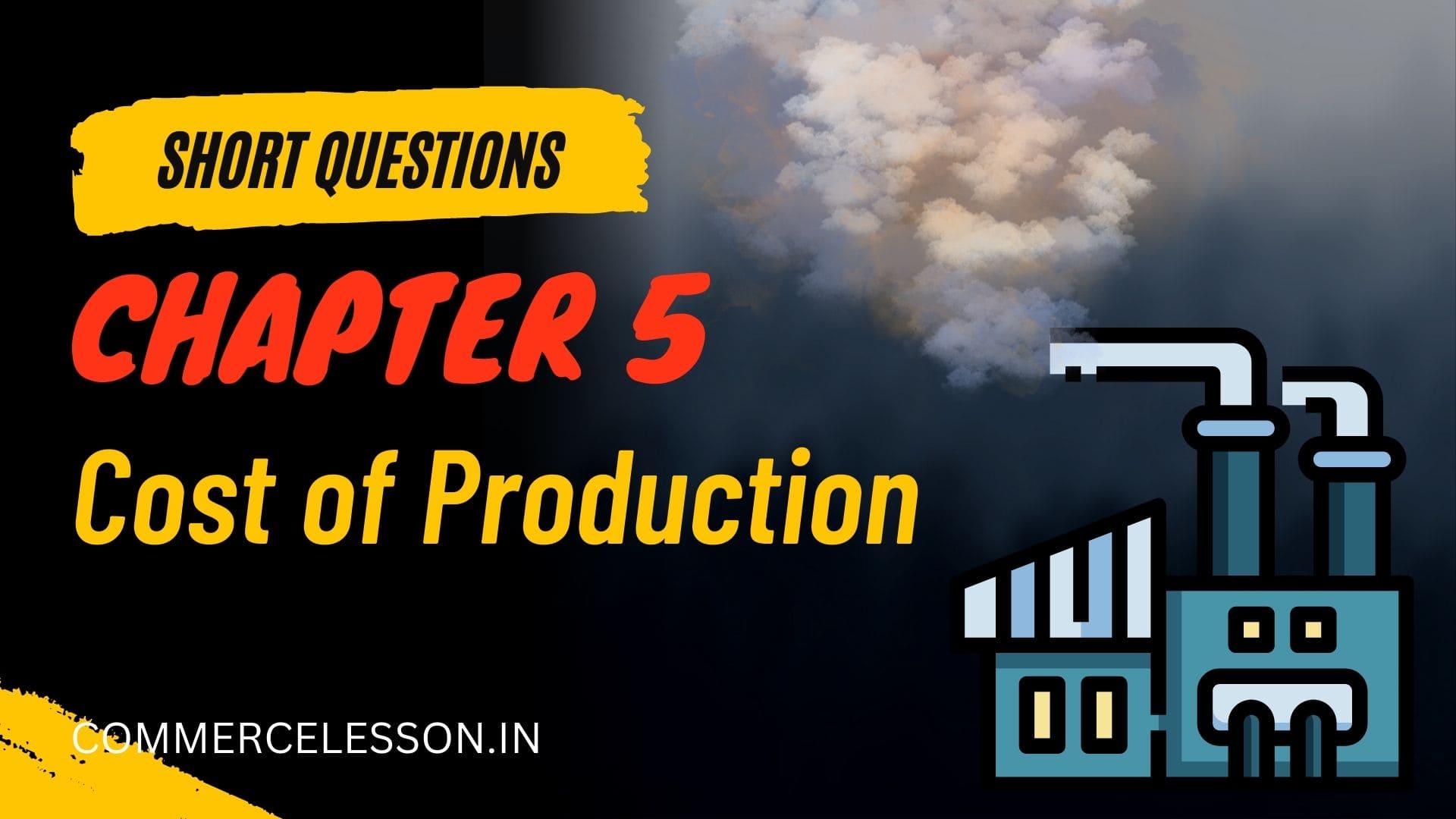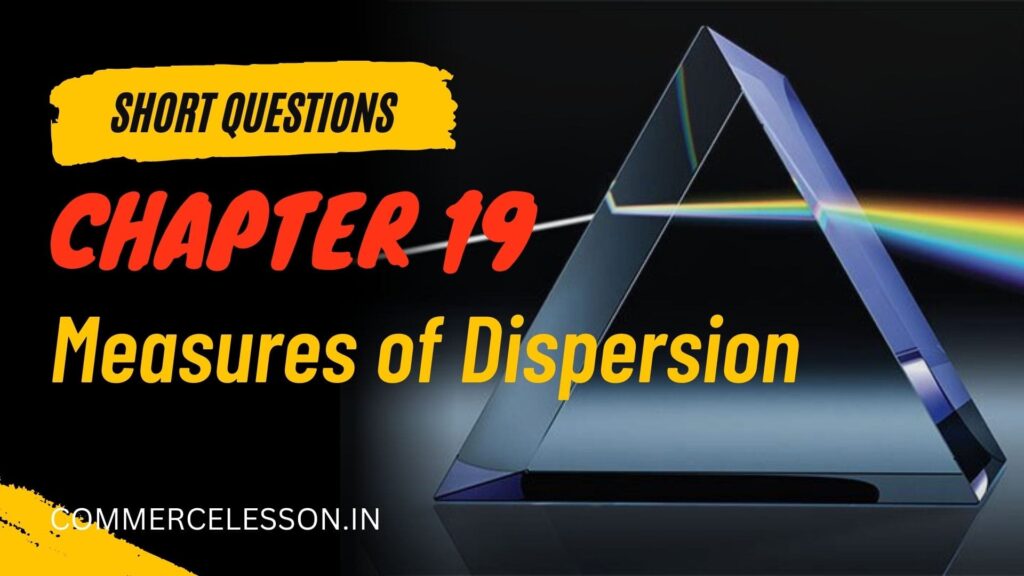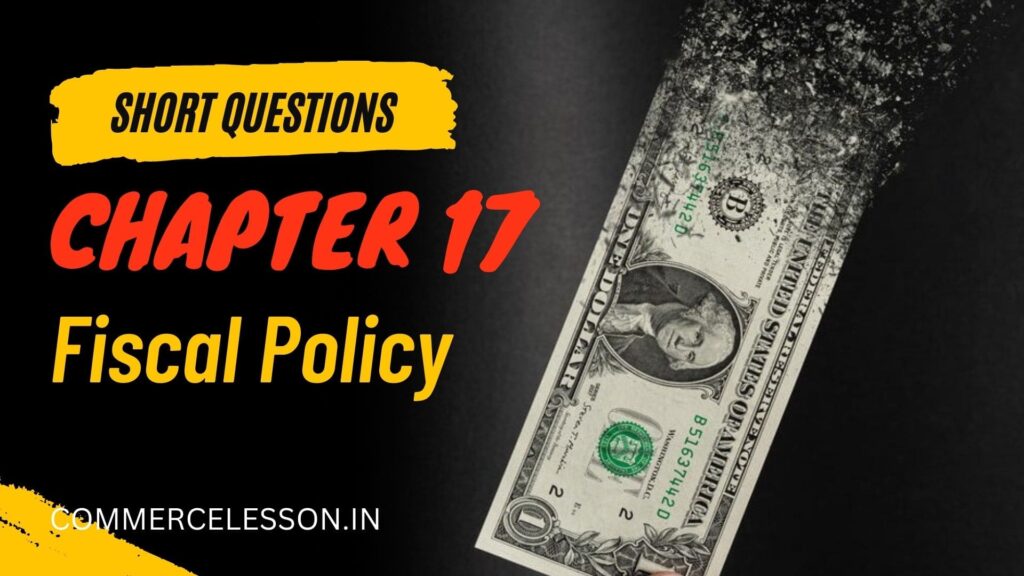Chapter 5 : Cost of Production | Short Questions [2 Marks each]
1. What is opportunity cost? Give examples.
Answer: The opportunity cost of any factor of production is the amount of earning which could have been obtained in the next best alternative use. For example – A firm can earn Rs. 14,000 from in-house production or it can earn Rs. 12,000 by renting the production facility to another firm. So, Rs. 12,000 is opportunity cost for in-house production.
2. What is fixed cost of production? Give examples.
Or, What is meant by fixed cost of a firm? [2022]
Answer: Fixed cost is that cost which does not change with the change in level of output. For example, rent of machinery used for production is a fixed cost as whatever the level of production is, 0, 10, or 1000 units, the firm has to pay the rent fixed for the machinery.
3. Give two examples of fixed cost of a firm. [2015]
Or, Give two examples of a firm’s fixed cost of production. [2018, 2023]
Answer: Two examples of fixed costs are – interest on loan taken by the firm and insurance premium.
4. What is variable cost of production? Give examples.
Answer: Variable cost is that cost which changes with the change in level of output. For example, cost of raw materials is a variable cost as cost of raw materials changes with the level of output.
5. Give two examples of firm’s variable cost. [2017]
Or, Give two examples of a firm’s variable cost of production. [2019, 2022]
Answer: Two examples of variable costs are – raw material costs and transport costs.
6. Distinguish between fixed cost and variable cost.
Answer:
| Fixed Cost | Variable Cost |
|---|---|
| Fixed cost does not change with the change in level of output. | Variable cost changes with the change in level of output. |
| Fixed costs exist only in short run. | Variable costs exist both in short and long run. |
7. What will be the shape of short run TVC curve?
Answer: In the short run, TVC curve starts from the origin and is shaped as ‘inverted-S’.
8. What will be the shape of short run TC curve?
Answer: In the short run, TC curve starts from the vertical axis and is shaped as ‘inverted-S’.
9. In the short run what will be total cost if total production is zero?
Answer: In the short run, if total production is zero, total cost (TC) = total fixed cost (TFC).
10. What do you mean by average cost of a firm? [2017]
Answer: Average cost can be defined as total cost per unit of output. Therefore, Average Cost (AC) = Total Cost (TC) / Total Output.
11. What will be the shape of the AC curve?
Answer: AC curve will be ‘U’ shaped.
12. Why AC curve is ‘U’ shaped?
Answer: As the output level increases, the average cost (AC) first decreases and then increases. This is why AC curve is ‘U’ shaped.
13. How can average cost obtained at any point of the total cost curve?
Answer: At any point of the total cost (TC) curve, Average Cost (AC) = Total Cost / unit of production at that point.
14. At which point of the total cost curve will the average cost be minimum?
Answer: Average cost will be minimum at the point which can be obtained from a tangent from the origin.
15. Define average fixed cost. Can it be zero? Give reasons.
Answer: Average fixed cost can be defined as total fixed cost per unit of output. Therefore, Average Fixed Cost (AFC) = Total Fixed Cost (TFC) / Total Output.
Average fixed cost (AFC) can never be zero as total fixed cost (TFC) can never be zero even if no unit is produced.
16. Why the shape of short run average fixed cost (AFC) curve is rectangular hyperbola?
Answer: If we take any point on the AFC curve and draw two perpendiculars on the two axes, we get a triangle. The area of the triangle represents total fixed cost (TFC) which remains constant at all levels of output. That is why AFC curve is a rectangular hyperbola.
17. How can total fixed cost be obtained at any point of the average fixed cost curve?
Answer: At any point of the Average Fixed Cost (AFC) curve, Total Fixed Cost (TFC) = AFC x Output at that point.
18. What do you mean by marginal cost?
Or, Define marginal cost of production. [2016]
Or, Define marginal cost of production of a firm. [2018, 2023]
Answer: Marginal cost refers to the additional cost of producing one additional unit of output. Therefore, Marginal Cost (MC) = TC(n) – TC(n-1) .
19. What will be the shape of the short run MC curve?
Answer: In the short run, MC curve will be ‘U’ shaped.
20. Why MC curve is ‘U’ shaped?
Answer: As the output level increases, the marginal cost (MC) first decreases and then increases. This is why MC curve is ‘U’ shaped.
21. Is fixed cost included in marginal cost?
Answer: No, fixed cost is not included in marginal cost.
22. How can marginal cost be measured at any point of the total cost curve?
Answer: At any point of the total cost (TC) curve, Marginal Cost (MC) of nth unit of output = Total Cost (TC) of n units of output – Total Cost (TC) of (n-1) units of output.
23. What happens to MC at the point of inflexion of the TC curve?
Answer: At the point of inflexion of the TC curve, MC is minimum.
24. State the relation between AC and MC.
Or, State the relation between Average and Marginal Cost of production. [2015]
Answer: When AC decreases, MC < AC, when AC increases, MC > AC and when AC is stationary, MC = AC.
25. When is MC equal to AC?
Answer: When AC is stationary i.e. neither increases nor decreases, MC = AC.
26. When average cost decreases can marginal cost increase?
Answer: This can happen when the production of additional units requires additional resources that are more expensive than the resources used for the previous units.
27. Why can the long run cost not exceed short run cost?
Or, Why long run cost never exceed short run cost of production? [2016]
Answer: Whether increases of decreases the production, the firm has to bear the fixed cost which were incurred in the short run. That’s why short run cost will be be always equal or greater than long run cost. In other words, long run cost can never exceed short run cost of production.
28. In the long run what will be total cost if total production is zero?
Answer: In the long run, if total production is zero, total cost (TC) = 0.
29. When does the long run TC curve become a straight line through the origin?
Answer: In case of Constant Returns to Scale (CRS) is in operation, long run TC curve becomes a straight line through the origin.
30. When does the long run AC curve pass through the minimum points of short run AC curves?
Answer: In case of Constant Return to Scale (CRS), the LAC curve will be a horizontal straight line and pass through the minimum points of short run AC curves.
31. If in the production process only constant returns to scale prevails, what will be the shapes of long run average and long run marginal cost curves? [2019]
Answer: If in the production process only constant returns to scale prevails, LAC and LMC will be a horizontal straight line where LAC = LMC.
Like our post?
We are available with lots and lots of commerce-related content.





Thank you sir,pl.upload suggestive long questions from the chapter.
[…] Cost of Production | Short Questions | Economics | WBCHSE | Higher Secondary | Class 12 […]
[…] Cost of Production | Short Questions | Economics | WBCHSE | Higher Secondary | Class 12 […]